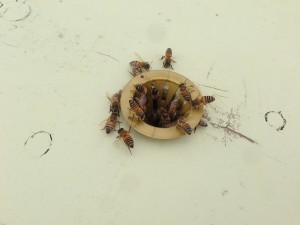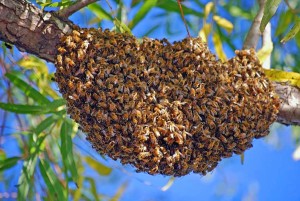The Moment of Truth…
I recently got a call from someone needing a bee swarm removed in the Prescott Valley of Arizona. Although it’s about a 1 1/2 hour drive down there, I felt like this would be a great opportunity to get the word out about our bee removal and re-homing services. Currently, we have a waiting list in the Flagstaff area of people and groups wanting bees or hives. So when I got the call from someone saying they had a swarm in their tree I thought I should really jump on the opportunity.
Swarms are much easier to collect and a lot less work than established hives. When bees swarm and ball up they tend to be much less aggressive and simply focused on staying together and finding a new home, rather than defending their hive and attacking people…but then again this is killer bee territory. Ok, so maybe they have gotten a bad wrap, and don’t really deserve the term “killer”. But there are also good reasons for that name, as a number of people, pets, and livestock have been the victim of this particular strain of Africanized hybrid bees that have been slowly spreading from Brazil in the 1950s and entering into the US by 1990, becoming the most successful invasive takeover of any other species of plant or animal. Most of southern Arizona is 90% Africanized territory, whereas here in Flagstaff we’re probably hovering around 30%. So that means that down near the middle we’ve got around a 50/50 chance of encountering an Africanized (killer) bee swarm. Something not favorable for most re-homing situations.
Thinking about this I began to wonder. Was my journey down south going to be successful? Would it be worth my time? Would I be able to find a home for these ladies, or would they be too difficult to pass on to someone else? Apart from simply being able to help out someone in need of removal, I also found out that the lady requesting our help was highly allergic to bees and even carried an epi-pen. So I figured “Hey, helping someone out in need, plus a little road trip, experience, and the potential for new bees for those on our waiting list? Why not?” Driving down south to the Prescott Valley area I went a little off the main roads in the area to a charming country home that was idyllic for living the farm-to-fork lifestyle. Meeting Melanie as I got there, she showed me around a bit. Herb gardens, fruit trees, fancy free-range chickens, geese, cats, dogs, and…bees.
 There they were, the reason why I had come all this way. As I approached one of the small cherry trees they had planted, there was a black void about the size of a football in the midst of green leaves. The bee swarm. After talking with Melanie for a few minutes about the nature of bees and swarms and my plans to remove and re-home them, I had her retreat back to the safety of her house since she was allergic and because after all, this was potential “killer bee country”. The last thing I would want to happen would for her to get stung by my shaking up the swarm. So there I was, just me, the bees, and a pen of chickens nearby clucking and cooing nervously.
There they were, the reason why I had come all this way. As I approached one of the small cherry trees they had planted, there was a black void about the size of a football in the midst of green leaves. The bee swarm. After talking with Melanie for a few minutes about the nature of bees and swarms and my plans to remove and re-home them, I had her retreat back to the safety of her house since she was allergic and because after all, this was potential “killer bee country”. The last thing I would want to happen would for her to get stung by my shaking up the swarm. So there I was, just me, the bees, and a pen of chickens nearby clucking and cooing nervously.
When approaching a bee removal, most of what you do for the first half of removal is survey the situation, plan a course of action, change that plan, get a drink of water, think of your alternative removal options, check for holes and openings in your outfit, and pray to the Maker that a bee doesn’t find its way up the inside of your pant leg. The easiest way to remove the bees in a swarm like this would be to cut the branch they’re on, lower it into the box, brush them off, and go home. That wasn’t going to be an option here. Being a young fruit tree I didn’t want to remove any branches, and besides, they were balled at an intersection of about 3 different branches. Time for plan B.
Time for the moment of truth…
Was this an Africanized colony? Would they go crazy and prevent any sort of easy capture? Would they find their way up my pant leg and totally ruin my day and potential for future child-rearing? Time to find out. So just how do you get a swarm of bees out of a tree? You shake them off. Grab hold of the branch and shake them off so that they come crashing down through the branches and leaves, plummeting towards the earth…hopefully in a precisely quasi-calculated direction near the boxes you have beneath. When you shake them the inescapable force of gravity hurdles them downward into a box, branch, ground, or foot…resulting in a cloud of black and yellow. You then calmly step back through the mellifera maelstrom of 5,000 little dive-bombers to survey the carnage and regroup.
So there I was with my hand on the branch, thinking through this all…and over thinking some issues (mostly pant leg related ones). Well, there’s no time like the present. Sorry ladies. Here we go. Showtime.
Remember that frightening sound when you’ve fallen asleep on the couch watching a movie and the VCR powers off? For some reason, the pocket-protecting-powerminds that created and built the technology of the tv decided to play the world’s greatest practical joke. The invention of the loudest 15 seconds of your life…white noise. That insanely loud “chshhhhhhhhhh” that makes you jump up in a panic, frantically pushing every button on the tv (except the right one) trying in vain to end the chaotic interpretive dancing of black and white squiggles across your screen, while blasting all at once every sound known to man through those speakers. For you progeny of the 90s and beyond, you have no idea what I mean and have just wasted 30 seconds of your life. My practical joke on you.
Recall that sound and startled feeling, and you might understand what it’s like when you’ve shaken a swarm of bees out of a tree. Roaring white noise, and chaotic squiggles dancing in every direction. Step…back…slowly. Did the queen come down with most of the bees, or is she still remaining on the branch with 1/3 of the bees? Who knows. Can’t tell. Gotta re-shake the branch. More bees, more chaos, more pant leg checking. Repeat this process a few times. Grab a handful of bees off the branch and shake them into the sea of other bees in the little hive box. Hey, look at this! They’re all starting to collect themselves into the same box now. Bees from the branch, the grass, other boxes, your face…all starting to make their way back together. Now to collect the stragglers with a little help from the girls.
 Take the bee box about 20 feet away from the tree which still smells like where the bees balled up at, put a lid with a hole in it on top, and let the little ladies call everyone else home. A literal booty call. Backsides high in the air and standing on their tippytoes a small gathering of bees begin to fan their wings around the hive box entrance while wafting pheromones into the air, signaling to any bees in the air that this is where they’ve all gone and to join them. Take a little plastic funnel called a “bee escape”, reverse it, place it over the hole, and you have a swarm straggler collection device! One by one the bees make their way down the funnel and into the box, while having a hard time going back out the funnel in the opposite direction. Pretty soon the tree and air is nearly devoid of bees, and they’re all in the box. This is when you open your mind to the possibility that you’ve done it. You’ve actually pulled this off. And then you realize that these bees aren’t all that aggressive and haven’t been trying to destroy you. Even after going through all that, they still seem pretty mild-mannered and easygoing. Wow. I could have a potentially workable hive here!
Take the bee box about 20 feet away from the tree which still smells like where the bees balled up at, put a lid with a hole in it on top, and let the little ladies call everyone else home. A literal booty call. Backsides high in the air and standing on their tippytoes a small gathering of bees begin to fan their wings around the hive box entrance while wafting pheromones into the air, signaling to any bees in the air that this is where they’ve all gone and to join them. Take a little plastic funnel called a “bee escape”, reverse it, place it over the hole, and you have a swarm straggler collection device! One by one the bees make their way down the funnel and into the box, while having a hard time going back out the funnel in the opposite direction. Pretty soon the tree and air is nearly devoid of bees, and they’re all in the box. This is when you open your mind to the possibility that you’ve done it. You’ve actually pulled this off. And then you realize that these bees aren’t all that aggressive and haven’t been trying to destroy you. Even after going through all that, they still seem pretty mild-mannered and easygoing. Wow. I could have a potentially workable hive here!
After clean-up and talking to Melanie a bit more about her animal and gardening operation there, she went out of her way with a donation for gas and my time, and a handful of herbs she’s been growing in her front garden. A fair trade I’d say. Isn’t that what life, neighbors, and even complete strangers should be about? Helping out one another and giving whatever tutelage, talent, or thyme you may have extra of? Sure would make the world a better place if we all did that. That’s the kind of people I’ve come to find here in Flagstaff and Northern Arizona. Sure, like the bees, we may have some people that are aggressive, defensive, and downright mean. But we also have many I’ve come across in random places that are as golden and warm as a glowing beeswax candle, and that helps add just a little more sweetness to life each and every day. Those are the people I want in my hive.
Nate
Royal Kenyon BeeWorks
www.KenyonBee.com


